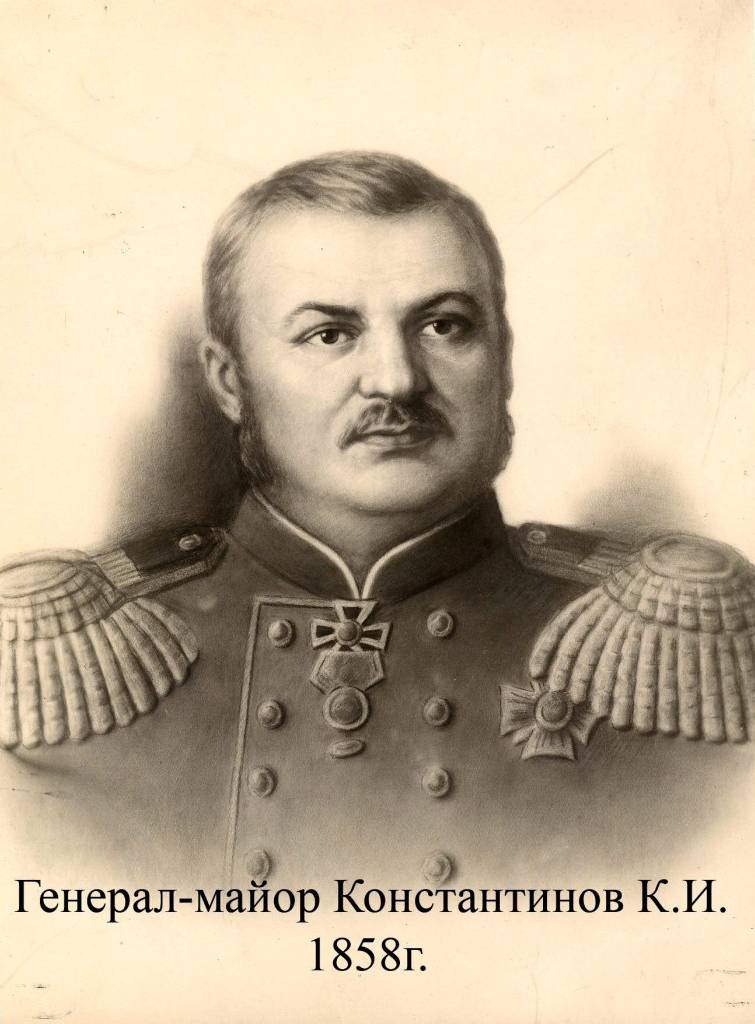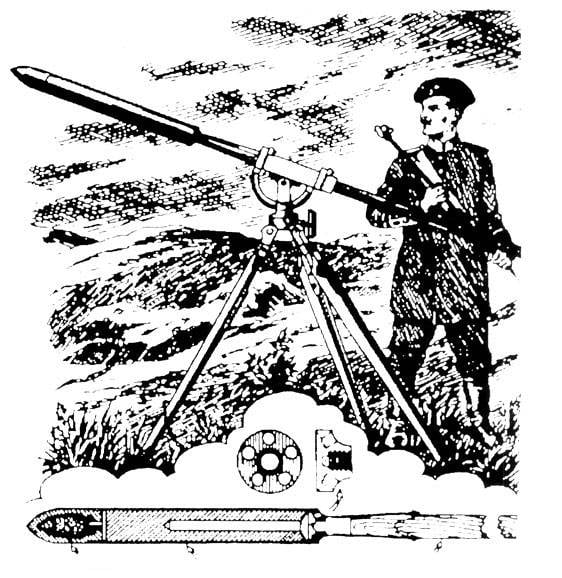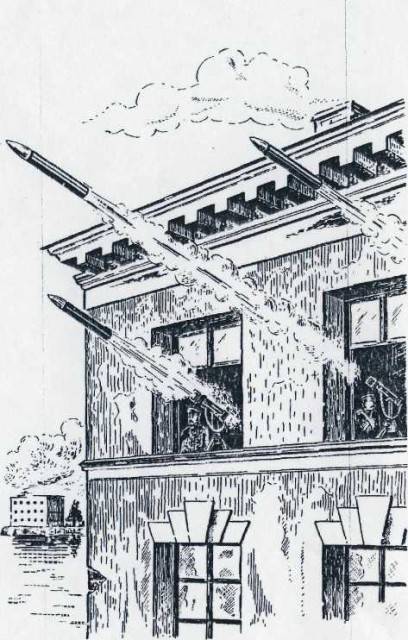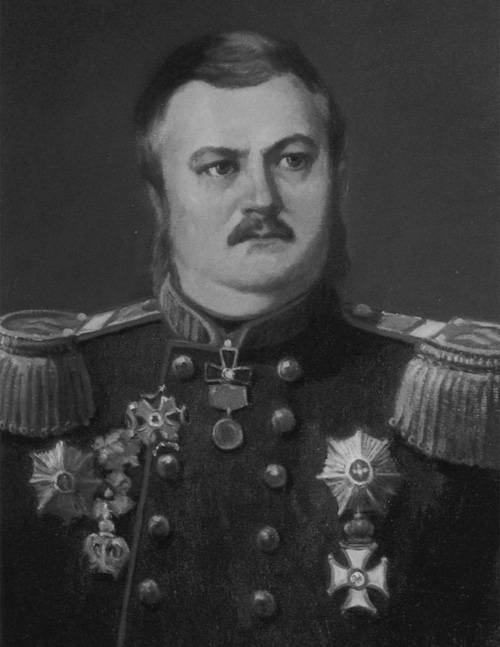Russia's first missile

Foreign experience warmed up the inventive abilities of the Russian rocket engineer. And he visited many European countries: Austria, England, Belgium, Holland, Prussia, France.
By this time, Konstantinov made the first invention - an electroballistic device. Then in the year 1844 also offered a sight for mounted shooting from smooth guns. After returning to Russia, he tested his installation for measuring the velocity of an artillery projectile.
On a business trip to Austria, he decided to meet with a prominent specialist in rocket technology, a Swede, Major General Baron Wienzs von Augustine, and head of the Austrian corps of rocket engineers and laboratory technicians. On the rocket field, prior to the examination, Konstantinov told him about his ballistic rocket pendulum. Augustin said that Konstantinov "began with what he, Augustine, should have finished," thereby recognizing the high talent of the young inventor.
The ballistic pendulum was designed to measure the thrust of the powder engine, which allowed Konstantinov to investigate the influence of the shape and design of the rocket on its ballistic properties, laying the scientific foundations for calculating and designing missiles. In fact, the methodology for studying the intraballistic characteristics of rocket engines using the Konstantinov pendulum is a prototype of modern fire tests! For many years, the Konstantinov pendulum remained the most advanced tool for studying traction parameters of a rocket engine.
In 1850, by the highest order, Colonel Konstantinov was appointed commander of the oldest Petersburg rocket institution, Russia's first industrial enterprise for the production of military missiles. One of the activities of Konstantinov was the improvement of production, above all the improvement of the technology for the manufacture of combat missiles, the assembly of missiles, the mechanization and safety of their manufacture.
Konstantinov was a zealot for the rocket armament of ships. And he did a lot for their application in navy. So, he published a work in the Marine Collection, in which he analyzed all the proposals related to scuba diving. In it, he appreciated the proposals of the famous Russian engineer, Adjutant General Karl Schilder, who used military missiles on the world's first metal submarine.
Konstantinov’s missiles were also used in the defense of Sevastopol. In early February 1855, the enemy attacked the advanced lines of the defense of Sevastopol with Kongrev’s missiles. From the trenches spread out over the bastion, enemy missiles fell into the squadron's location under the command of Vice Admiral Pavel Nakhimov. The ship Grand Duke Constantine was burned a little bit by these missiles. Then the assistant Konstantinov Philemon Pestich decided to strike with his missiles at the enemy from the upper floor of the barracks. Determined the angle of elevation - in 20 degrees. At the first shot, the rocket flew over the notch and fell into the enemy's front trench. The British soldiers threw off the sapper shovels and rushed from the rocket in different directions along the courses of the trench they had dug. “Speaking of your Highness about this,” wrote Vice-Admiral Pavel Nakhimov to February 16 of 1855 of the year, Adjutant General Prince Alexander Menshikov, “I have the honor to add that the missiles thrown by the enemy, mostly bursting, with a strong incendiary composition; and the range extends to two thousand fathoms. "
This report served an important service for Konstantinov - he began to receive urgent large orders for the manufacture and supply of domestic missiles for the Eastern campaign ...
A brief, but very significant episode in the life and work of Leo Tolstoy is connected with service in a rocket institution under the command of Konstantinov. After the heroic Sevastopol strada, he was seconded to Petersburg. Tolstoy, who arrived at the new 21 service station on November 1855 of the year, was ordered by the inspector of all artillery from December 27 No. 435 into the rocket battery at the rocket institution. Lieutenant Tolstoy, who was very sympathetic to Konstantinov, communicated with him eagerly, often visited his commander in Razezzhaya and always spoke warmly of him. From Tolstoy’s diary entries (May 16 - December 9 1856), when visiting Konstantinov, Tolstoy had lunch or dinner with him, met in his apartment with famous artillerymen and missilemen. But, not seeing the prospects for his service in artillery, Tolstoy started a conversation about resigning, but Konstantinov dissuaded him. Despite the entreaties, Tolstoy still went to Yasnaya Polyana, from where he sent letters to his commander. And on December 29, 1856 wrote a report on the resignation to the head of the St. Petersburg rocket establishment Konstantinov.

Launcher and 2-inch Konstantinov rocket
In March, 1857, Konstantinov was sent abroad to order all the technical devices for the newly designed rocket plant. Although the main task of Konstantinov remained: "... to get acquainted in the closest manner with the rocket establishments now existing in France, of which one is in Toulon and the second in Metz." Despite the secrecy of information, he managed to acquire them. Apparently, economic intelligence was under his power. In addition, he believed that scientific knowledge could not be concealed in one country, so that the successes of civilization throughout the world would not be interrupted.
Konstantinov, at his own risk and risk, ordered the equipment for a new rocket institution in Paris according to his drawings at the factory, which was owned by Emmanuel Denis Farko, in Paris. Emperor Alexander II in August 1859 of the year approved the order of Konstantinov, and also agreed with his proposal to allocate the rocket teams to an independent branch of the military, in need of their own command. It is possible to consider the created administration with its headquarters, the rocket division, its own rocket factories and rocket polygons as a prototype of the modern domestic rocket forces.
The fruitful activity of Major General Konstantinov, head of the Directorate for the production and use of combat missiles in the improvement of combat missiles and missile production, made a special impression even on the monarchs of the friendly countries of Russia - in 1859, he was rained on orders. He received the Russian Order of St. Stanislav I degree, the Commander Cross of the Order of the Netherlands Lion, the Spanish Order of Isabella the Catholic ...
1860 year brought into private life Konstatinova significant events. The noble deputy assembly of St. Petersburg granted a request for recognition of its hereditary nobility, and the Senate determined to include the name Konstantinov in the second part of the noble family tree of the St. Petersburg province with the production of a diploma and a coat of arms.

Konstantinov field rocket with a rocket
It seemed that justice in the fate of Konstantinov triumphed. But it’s not for nothing that they say that children are responsible for the sins of their fathers. Only recently a similar fact was established, carefully concealed for many years. From a civil marriage with Sophia Rutkovskaya 17 in July 1860, in the village of Murzinka, Shlisselburgskiy district, a son was born - Vladimir Konstantinovich Konstantinov. Probably, before the birth of her son, Sophia Pavlovna lived in the Konstantinovs' apartment on Razazhezha Street, and when it came time to give birth, Konstantin Ivanovich rented a dacha for her in Murzinka, away from people's eyes and curses. Here was the birth of his illegitimate son Vladimir. But a year later his mother died. Not being able to participate in the upbringing of his son, Konstantin Ivanovich, who at that time was on a business trip abroad, asked his relatives to find a nurse-nurse who could constantly look after the child. Thus, the only son of Konstantin Ivanovich, a hereditary nobleman, grew up practically without a father and mother.
And the strength tests all intensified.
The fact is that the rifled artillery, much more accurate and rapid-firing in comparison with the missiles, has replaced the outdated smooth-bore heavy weapons. This gave rise to doubts in the Russian leadership about the prospects and effectiveness of rocket weapons in principle, doubt in the construction of the rocket plant is Konstantinov's favorite brainchild. The special equipment developed by him turned out to be so perfect that the Spanish government ordered exactly the same for its new rocket plant in Seville in Paris. The main difference of this plant was “teledynamic motion transmission”, mechanization and automation of production cycles. The machines, machines, instruments and technology for the continuous production of rockets developed by Konstantinov turned into the largest automated production in Russia and Europe.
In addition, by that time Konstantinov was not just the creator, but also the chronicler of the missiles, made the first complete course of rocket artillery, a course of international importance. In 1859 – 1861, Konstantinov gave a series of lectures at his alma mater for artillery officers on missiles. In 1861, these lectures were published in Paris in French, and then in Russian. This, then the only in the world, fundamental monograph was highly appreciated in scientific circles, including the Paris Academy of Sciences. The author was awarded the prize of the Mikhailovsky Artillery Academy (former Mikhailovsky School) in Russia.

"The appearance of this work should be considered in military literature as an important event, because in it with scientific thoroughness and in a publicly accessible way is considered a subject about which (if we exclude previous works of the same author) only insufficient and superficial information was printed so far," military observers wrote . “The author was able to highlight the rocket issue as thoroughly as gracefully in all respects (historical, technical, physical and tactical).”
K.I. Konstantinov, in his lectures, was the first of the rocket specialists all over the world who came very close to one of the most important laws of rocket movement:
"At each moment of burning rocket composition, the amount of movement reported to the rocket is equal to the amount of movement of the exhaust gases." The mathematical form of this law gave another domestic scientist; it is known worldwide as the "Tsiolkovsky formula".
The main missile empire rushed to defend the future of the missiles. He then said a catch phrase to the leadership of the country: "Do not break the thread of events." And he passed the most serious examination at a special imperial commission, gathered to clarify the need to build a new rocket plant.
Emperor Alexander II decided to establish a special commission composed of the feldtseyhmeister general of Grand Duke Mikhail Pavlovich (chairman), generals Sergei Sumarokov, B.I. Markhlevich, Alexei Dyadin, Eduard Brimmer, Alexander Barantsov, Eduard Totleben, Nikolai Kryzhanovsky, Alexander Villimov, Konstantin Konstantinov (members of the commission). The Commission unanimously acknowledged the use of combat missiles as an aid, mainly in the defense of fortresses, and came to the conclusion that it was necessary to establish a new rocket institution. Thus, perseverance, conviction, hard work, dedication and hot perseverance, supported by high erudition, deep scientific knowledge and inventive ingenuity of Konstantinov, defended the future of the rocket right up to modern ballistic.
Konstantinov built a new Nicholas rocket plant, was appointed as its chief and moved to live in the city of Nikolaev.
At this time, he presented a new rocket system to the missile system - an 2-inch military missile, a launcher for it, and a shock launching pad. After the highest approval, the missile system was adopted by the Russian army. The recognition of rocket weapons as a necessary and effective addition to rifled artillery!
All gunners know that the rocket launcher of Lieutenant-General Konstantinov's salvo attack became the prototype of the legendary Russian "Katyushas" during the Great Patriotic War.

In 1871, General Konstantinov died in Nikolaev and was solemnly buried in the Church of the Nativity of the Most Holy Mother of God in the village of Nivnoe, Mglin district, Chernihiv province.
It is noteworthy that in the church K.I. Konstantinov was funeralized according to Orthodox canons, including the psalm-reader Nikolay Kibalchich. Obviously, Andrei Lishin noticed him here and patted about his admission to the St. Petersburg Institute of Railway Engineers. It was then that revolutionary aspirations brought Kibalchich to prison. Still, even sentenced to death, he left his project of a spacecraft.
Information